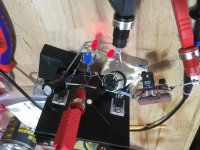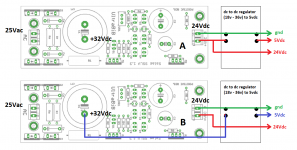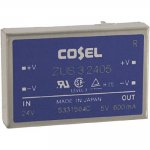Many thanks for the hand holding. 😀
You've been a help in the past also.

No worries. Check all joints with a magnifying glass and beautify them while you are at it.
For what gear you made this ultrareg by the way?
Good for the price, compact & quiet enough, still it belongs to the mediocre bench PSU category in general. But not many decent choices there. The cheaper model with two digits after the dot resolution is enough.
Thanks. Will keep looking.
Tks Salas. In that low power comsuption is possible to use Ubib on rpi?OK I also burned that one's image and run it. 522mA max (moments) and 212mA average during boot. Then it turns the HDMI off, the green lights don't blink anymore, and it pulls 217mA steadily.
Power wise it looks ok but we had reports about the RPi doing funny things when on it. Maybe a matter of provoking instability or it doesn't like a CCS limit (?). Try for yourself with high R9, say 2.2k and 750mA limit, see if it will work for you.
No worries. Check all joints with a magnifying glass and beautify them while you are at it.
For what gear you made this ultrareg by the way?
The ultras are for the Twisted Pear ESS-9038Pro and Mercury I/V boards.
The Mercury IV/V +-15v regs were the previous version BiBs. I replaced them first last week and the sonics improved 🙂 .
The DAC was powered by the Reflektor-D reg. I putoff changing it, I thought it wouldn't make a difference. I was wrong, more details were revealed in the sonic fabric!
Now I'm wondering if replacing the common three terminal 5v reg powering the BeagleBoneBlack will make a difference.
Salas, thank you very much for your continued improvements of your regs.
-ICHI
ps - I have to try an ultra on the PASS B1-NuTube preamp, now powered with a lowly three terminal reg.
Nice. Good luck with new applications and keep us posted.
Regarding mini computers doing funny stuff, now I am thinking, what would happen if you guys had an on/off switch at the voltage output? Just in case its the soft-start power on inherent in the reg that a booting computer races against? So to can turn on the computer separately after the reg is on. Hmm...
Regarding mini computers doing funny stuff, now I am thinking, what would happen if you guys had an on/off switch at the voltage output? Just in case its the soft-start power on inherent in the reg that a booting computer races against? So to can turn on the computer separately after the reg is on. Hmm...
The ultras are for the Twisted Pear ESS-9038Pro and Mercury I/V boards.
...
The DAC was powered by the Reflektor-D reg. I putoff changing it, I thought it wouldn't make a difference. I was wrong, more details were revealed in the sonic fabric!
Great info, I'm planning an UltraBiB for my BII (so ready for BIIIPro) but was still wondering if Reflektor-D was a better choice. Thanks for the feedback.
The line was so straight, that I spent quite some time trying to figure out where the error in my measurement setup was.... 😎
Point to point can sometimes lead to less parasitics but I wasn't sure about it in that case as I assume that many of my leads are longer than the traces on the pcb. Anyhow, the regulator works as hoped for. Voltage falls slightly over about 10 minutes after switch on and remains stable.
It will help supply a DDDAC, I can't say anything about the subjective effects on sound quality as I haven't used that DAC with any other supply and for now am too lazy to try.
Source is a SMPS, filtered with ferrites on + and - and 560uF leaving 2.4mV RMS at 64kHz.
Point to point can sometimes lead to less parasitics but I wasn't sure about it in that case as I assume that many of my leads are longer than the traces on the pcb. Anyhow, the regulator works as hoped for. Voltage falls slightly over about 10 minutes after switch on and remains stable.
It will help supply a DDDAC, I can't say anything about the subjective effects on sound quality as I haven't used that DAC with any other supply and for now am too lazy to try.
Source is a SMPS, filtered with ferrites on + and - and 560uF leaving 2.4mV RMS at 64kHz.
hello salas,
i need 2 dc voltages regulation, 24v and 5v.
i am planing to use one ultrabib for 24v, and one small dc to dc reg. for 5v.
is it better to put the small 5v reg. after 24v or before? (as picture)
thanks.
Jumping in with as a bib user opinion:
I would avoid jumping to 5V from so high anyway(dissipation concern or switching noise otherwise);
also i would not burden the shunt with more than the exact calculated and expected load indicated as first step (choosing R1)
least but not last, a voltage regulator after a current regulator is at least weird.
The DC/DC collaboration is going to contaminate the Ubib's ground path with some switching noise anyway. Surely tap on the raw DC available at the main reservoir capacitor when you can't have an independent voltage source for the converter. Include a GND cable from C1's (-) to the switching converter. So both current paths to it are away from the output nodes at least and its not limited by the constant current source, avoiding extra heat also by not having to set extra constant current for it.
The DC/DC collaboration is going to contaminate the Ubib's ground path with some switching noise anyway. Surely tap on the raw DC available at the main reservoir capacitor when you can't have an independent voltage source for the converter. Include a GND cable from C1's (-) to the switching converter. So both current paths to it are away from the output nodes at least and its not limited by the constant current source, avoiding extra heat also by not having to set extra constant current for it.
okay thanks. noted.

btw for 5v i'm using cosel dc/dc converters. (this is what i have in hand)
datasheet says it can handle 18v-36v input for 5v output.
Attachments
They are very versatile those things for practical purposes. I tried a CUI one recently for some instrumentation op-amp phono experiments. 9-36V input, +/-24V output. I put a common mode choke on its input and RC filters on its output. To drop the rails voltage and improve on the noise. The opamps have very high PSRR anyway and the main switching noise is far beyond audio so lets try it I thought.
Although the phono's audio band was looking very clean on FFT because there are no hum frequencies in a DC/DC as it switches in the hundreds of kHz, and I could avoid a transformer's field near with using a wall wart, sadly the hiss went much noticeably up through wide band integration and the sound quality was off for dynamics and tonality too. Ultimately I replaced it with a Ubib and the sound went so much better. Night and day contrast better. Lesson is be practical for size and efficiency if you can but compare to know the compromises if any in various applications.
Chipomatic balanced input RIAA
Although the phono's audio band was looking very clean on FFT because there are no hum frequencies in a DC/DC as it switches in the hundreds of kHz, and I could avoid a transformer's field near with using a wall wart, sadly the hiss went much noticeably up through wide band integration and the sound quality was off for dynamics and tonality too. Ultimately I replaced it with a Ubib and the sound went so much better. Night and day contrast better. Lesson is be practical for size and efficiency if you can but compare to know the compromises if any in various applications.
Chipomatic balanced input RIAA
If you got Quasimodo to determine those, they will optimize ringing between your particular transformer and diodes. That can bring a blacker smoother background subjectively. It may also reduce grit in the treble. Not everyone likes those effects though. Some find such sound too relaxed. System synergy and tastes differ.
Hi Salas, I am looking to use the WIMA caps for some 5V (Soekris DAM), 17V (DCG3) and 24V (Korg B1) UBiB. Any recommendations? MKP?
I was wondering if people did some calculations what would be the values for R and C snubbers if you run something like 18VAC 50W transformer (Anteks from those from US)? I would assume that getting those parts not exactly calculated, but closely estimated would be better than not using any at all.
- Home
- Amplifiers
- Power Supplies
- Salas SSLV1.3 UltraBiB shunt regulator


